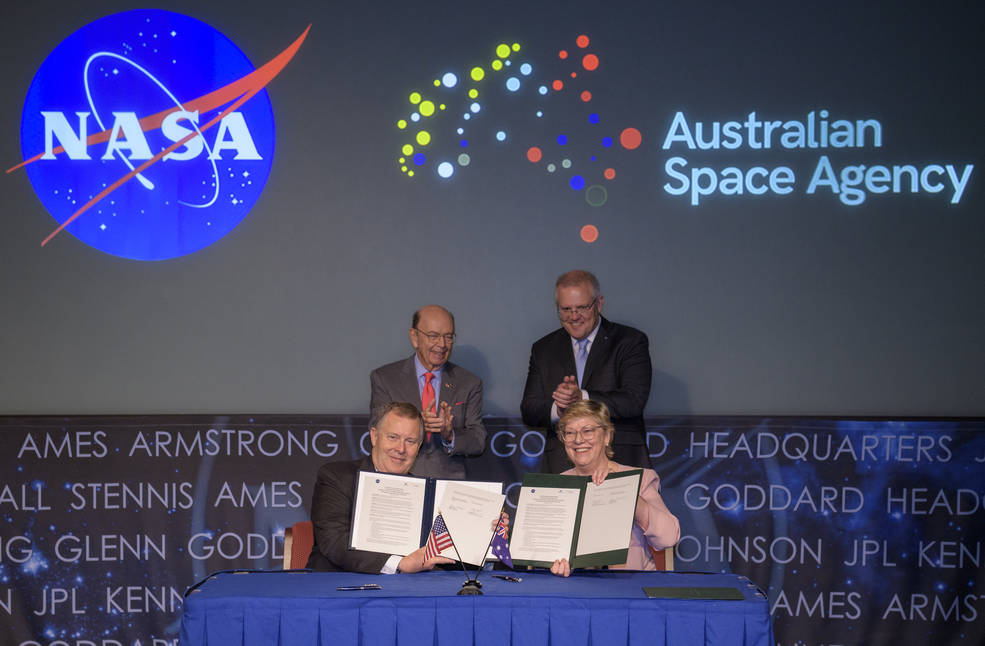The nascent Australian Space Agency (ASA) has signed an agreement with the United States’ National Aeronautics and Space Administration (NASA) to join in on the United States’ 21st Century sustainable off-planet ambitions, particularly the Moon to Mars missions, including NASA’s Artemis lunar program.
Prime Minister Scott Morrison announced Australia’s $150 million commitment at a ceremony last weekend at NASA Headquarters in Washington. The PM is currently on a diplomatic avoidance trip to the United States whereby he is doing everything he possibly can to avoid the Global Climate Summit in New York City, up to and including leaving the planet altogether.
The Moon to Mars missions and the Artemis lunar program represents some of the U.S.’s first big steps in the new space race against an ambitious China, a race across the solar system and that is becoming more and more solar powered.
In February, China announced its most audacious space project yet, a plan to place a multi-gigawatt solar plant in orbit which would transmit energy in the form of microwaves down to a land-based receiver. Theoretically, an orbiting solar array would not only bypass cloud cover but also nightfall and seasonal change, chasing uninterrupted sunlight.
The transmission of orbitally acquired solar energy may sound farfetched, but scientists from the California Institute of Technology developed a lightweight tile structure last year that is “capable of PV solar power capture, conversion to radio frequency power, and transmission through antennas. This modular tile can be repeated over an arbitrary area to form a large aperture which could be placed in orbit to collect sunlight and transmit electricity to any location.”
Chinese researchers have touted the wide fields of application for solar space stations, including the potential ability to deliver its uninterrupted solar power anywhere, be that remote locations on Earth, spacecraft and satellites, or even Moon-based space stations.
China’s solar powered ambitions, including plans for a moon-landing in the near future, triggered U.S. President Donald Trump to order an American return to the moon by 2024 with the aim of establishing a stepping stone base for NASA’s Mars programs, an ambition now shared by Australia.
Like its Chinese competitor, NASA is looking to utilise solar technology for its lunar and subsequent Mars missions. As reported on by pv magazine Australia yesterday, electric aviation is lagging behind in the electric transport revolution, but aviation outside of the Earth’s atmosphere is a different story. NASA is looking to utilise solar electric propulsion to develop its sustainable exploration practices. According to NASA, “this alternative propulsion system will enrich exploration at the Moon by enabling orbit transfers and reusable space tugs to and from the lunar surface.”
At the ceremony NASA Deputy Administrator, Jim Morhard, and Head of the ASA, Megan Clark, signed a joint statement of intent. “The strong relationship between NASA and the ASA affirms NASA’s commitment to establish sustainable exploration with our commercial and international partners by 2028,” said Morhard.
The ASA was established little over a year ago, but Australia has a long working history with NASA, including Australia’s famous live transmission of the images from the Apollo 11 Moon landing via the Parkes Observatory, better known as “The Dish”, also the title of the classic Aussie film which hilariously tells the story of a sheep paddock’s part in science’s great achievement of discovery.
Australia stands to get a lot out of cooperation with NASA. The Morrison Government’s 5-year $150 million investment is set to boost local business, as well as research and technology. Moreover, as the history of space exploration has proved time and time again, pushing the boundaries invariably advances life on Earth, with the solar industry set to benefit more than most. And, if everything goes according to plan, or even if it doesn’t, we might just get the long-awaited sequel to “The Dish”.
This content is protected by copyright and may not be reused. If you want to cooperate with us and would like to reuse some of our content, please contact: editors@pv-magazine.com.









By submitting this form you agree to pv magazine using your data for the purposes of publishing your comment.
Your personal data will only be disclosed or otherwise transmitted to third parties for the purposes of spam filtering or if this is necessary for technical maintenance of the website. Any other transfer to third parties will not take place unless this is justified on the basis of applicable data protection regulations or if pv magazine is legally obliged to do so.
You may revoke this consent at any time with effect for the future, in which case your personal data will be deleted immediately. Otherwise, your data will be deleted if pv magazine has processed your request or the purpose of data storage is fulfilled.
Further information on data privacy can be found in our Data Protection Policy.